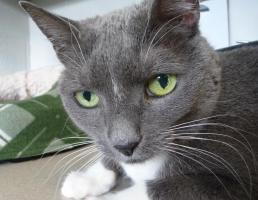Hyperthyroidism in Cats
- posted: Aug. 04, 2018
 Hyperthyroidism in Cats
Hyperthyroidism in Cats
One of the most common illnesses seen in senior cats at Patton Veterinary Hospital is hyperthyroidism. But what exactly is this disease, and what can be done to treat it?
Cats, dogs and people all have a gland located in the neck called the thyroid gland. The thyroid produces hormones that are responsible for regulating metabolism. These hormones help control heart rate, body temperature, how quickly or slowly the intestines process food and many other functions in the body. This condition is more common in cats over the age of seven, and the average age at which cats are diagnosed with hyperthyroidism is thirteen years.
Hyperthyroidism is caused by a non-cancerous tumor in the thyroid gland. The tumor causes the thyroid to produce excessive amounts of T4 thyroid hormone. In rare cases, a cancerous tumor can be responsible for hyperthyroidism, but 97% of cases are benign. With excess T4 circulating in the bloodstream, cats will develop a variety of symptoms. The most common symptom is weight loss despite the cat having a normal to increased appetite. Some hyperthyroid cats will be ravenous and drink excessive amounts of water but still lose weight. Hyperthyroid cats will usually also have an increased heart rate and may have diarrhea, vomiting and display anxious or hyper-active behavior. If not properly diagnosed and treated, hyperthyroidism can cause massive muscle wasting and high blood pressure which, in turn, could lead to blindness or heart failure.
Diagnosis is made by a simple blood test to check T4 levels, but it is important to screen for other health problems, so, in addition to the T4 level, a full blood chemistry panel and complete blood count are usually performed.
Cats can be treated and cured of hyperthyroidism with an injection of a radioactive isotope known as i131 therapy. The isotope targets and destroys only the abnormal cells in the thyroid gland leaving normal cells intact. While this cures the disease, some drawbacks may include higher up-front cost, limited treatment facilities and cats need to stay at the treatment facility for several days because the radioactive isotope is excreted in their urine. Hyperthyroidism can also be controlled using a medication called methimazole. This drug stops excessive T4 production, but does not kill the tumor cells and so cats need to remain on the medication for the rest of their lives. While tablets are absorbed best, methimazole can also be compounded into a flavored liquid or even into a gel that is rubbed on the ear to absorb through the skin for those kitties who are difficult to medicate. There is also a low iodine diet called Y/D made by Hill’s Science Diet that can be used to treat hyperthyroid cats, but, it can be a bit tricky to use in cats who live in multi-cat households.
If your cat is experiencing unexplained weight loss, diarrhea or other symptoms, have him screened for hyperthyroidism as well as other problems that may cause similar symptoms such as diabetes or kidney disease. If properly treated, symptoms will disappear and most cats can live a normal lifespan.
This blog brought to you by the Patton Veterinary Hospital serving Red Lion, York and the surrounding communities.
Location
Patton Veterinary Hospital
425 E Broadway
Red Lion, PA 17356
